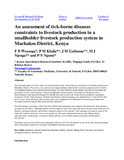An assessment of tick-borne diseases constraints to livestock production in a smallholder livestock production system in Machakos District, Kenya

View/
Date
2010Author
Wesonga, F D
Kitala, P M
Gathuma, J M
Njenga, M J
Ngumi, P N
Type
ArticleLanguage
enMetadata
Show full item recordAbstract
The principle objective of the study was to determine the tick- borne diseases constraints to livestock production in
Machakos District. The survey was carried out in eight randomly selected sub- locations spread across the district.
Two hundred farmers were recruited into the study. All cattle from the selected farms were bled to determine the
prevalence of tick- borne diseases. Clinical examination of sick animals was carried out during the survey.
Questionnaires with questions designed to identify and rank various tick- borne disease production constraints,
occurrence of tick- borne diseases, mortality and disease control strategies were administered. A total of 634 zebu
and 15 cross- breed (Friesian-zebu crosses) cattle were sampled on the 200 farms for blood parasite infections
(serology and direct parasite detection) and tick infestation.
From the farmers’ perceptive, East Coast fever (ECF) and anaplasma were ranked as the main tick -borne diseases
prevalent in the district. Although babesia was not ranked as one of the main tick-borne diseases in the district by the
farmers, serological analysis did indicate a high prevalence of the disease. Tick challenge was high in seven of the
eight sub-locations where the survey was carried out. The most common tick species were Rhipicephalus
appendiculatus, Amblyomma variegatum, Rhipicephalus evertsi, Rhipicephalus pulchellus and Boophilus
decoloratus.
Veterinary services in the district are inadequate with up to 92 % of the farmers in one of the sub-locations treating
their sick animals without the assistance of qualified veterinary personnel.
Citation
Wesonga, F. D et al(2010). An assessment of tick-borne diseases constraints to livestock production in a smallholder livestock production system in Machakos District, Kenya. Livestock Research for Rural Development; 22 (6)Publisher
Department of Public Health, pharmacology and Toxicology, University of Nairobi
Subject
AnaplasmaAnimal production constraints
Babesia
Disease ranking
East Coast fever
Prevalence
Serological analysis
Sub-location
Description
Journal article
